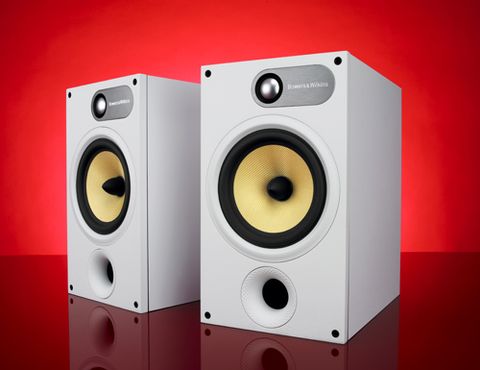The Bowers & Wilkins 685s burst onto the scene almost six years ago. They won awards in 2007 and 2008, and have managed to hold on to their five-star rating ever since. We last tested these veterans in a loudspeaker mega roundup in July last year, and liked them enough to highlight them as long-standing favourites.
That they have lasted this long at the top is nothing short of impressive, and we’ve developed a lot of admiration for them. But with new contenders on the scene it’s time to see if these greats still hold up.
B&W 685 review: design
It's not just the 685s' performance that has proved enduring. The square-edged, vinyl-wrapped cabinets are livened no end by a combination of soft-touch paint on the baffle, a shiny, asymmetrical tweeter arrangement and bright yellow Kevlar mid/bass driver.
Face on and grilles off, the B&W speakers remain interesting and individual lookers.
Placed where they're happiest (out in a little free space), toed-in slightly towards your listening position and single-wired (B&W fits biwire terminals to the 685s but we think they sound their best on a single length of cable), the B&Ws are the same engaging, energetic listen we've always loved.
Eli ‘Paperboy' Reed & The True Loves' scorching Come and Get It offers a tough test of timing, attack and midrange resolution, and it's a test the 685s positively relish.
B&W 685 review: performance
They create a wide, deep soundstage, and their powers of focus and separation mean it's simple to follow individual strands of the recording even as the speakers present a cogent and convincing whole.
The song's vaulting dynamics present no problems for these speakers, and there's a stack of detail available from the taut, well-defined top of the frequency range to the deep, speedy bottom. The soul holler in the midrange is packed with character, but not at the expense of transparency or precision.
B&W 685 review: treble
However, there's an undeniable discrepancy in character between the high frequencies served up by the metal-dome tweeter and the rest of the frequency range; the slightest suggestion that treble sounds were recorded in a different environment to the rest.
Added to that is the impression that the bass is a bit tubby, (improved by single-wiring them) and the 685s aren't quite enough in the current form to beat off the new competition.
B&W 685 review: verdict
So it’s four stars for the 685s. It says a lot for these B&Ws that they’ve only lost their fifth star after almost six years. And it’s not through any particular fault – there’s no shame in being outdone by newer opponents. These are very good all-rounders for the money, firmly holding on to their place in What Hi-Fi towers as old favourites
WATCH: B&W 685 video review
See all our hi-fi speaker Best Buys

